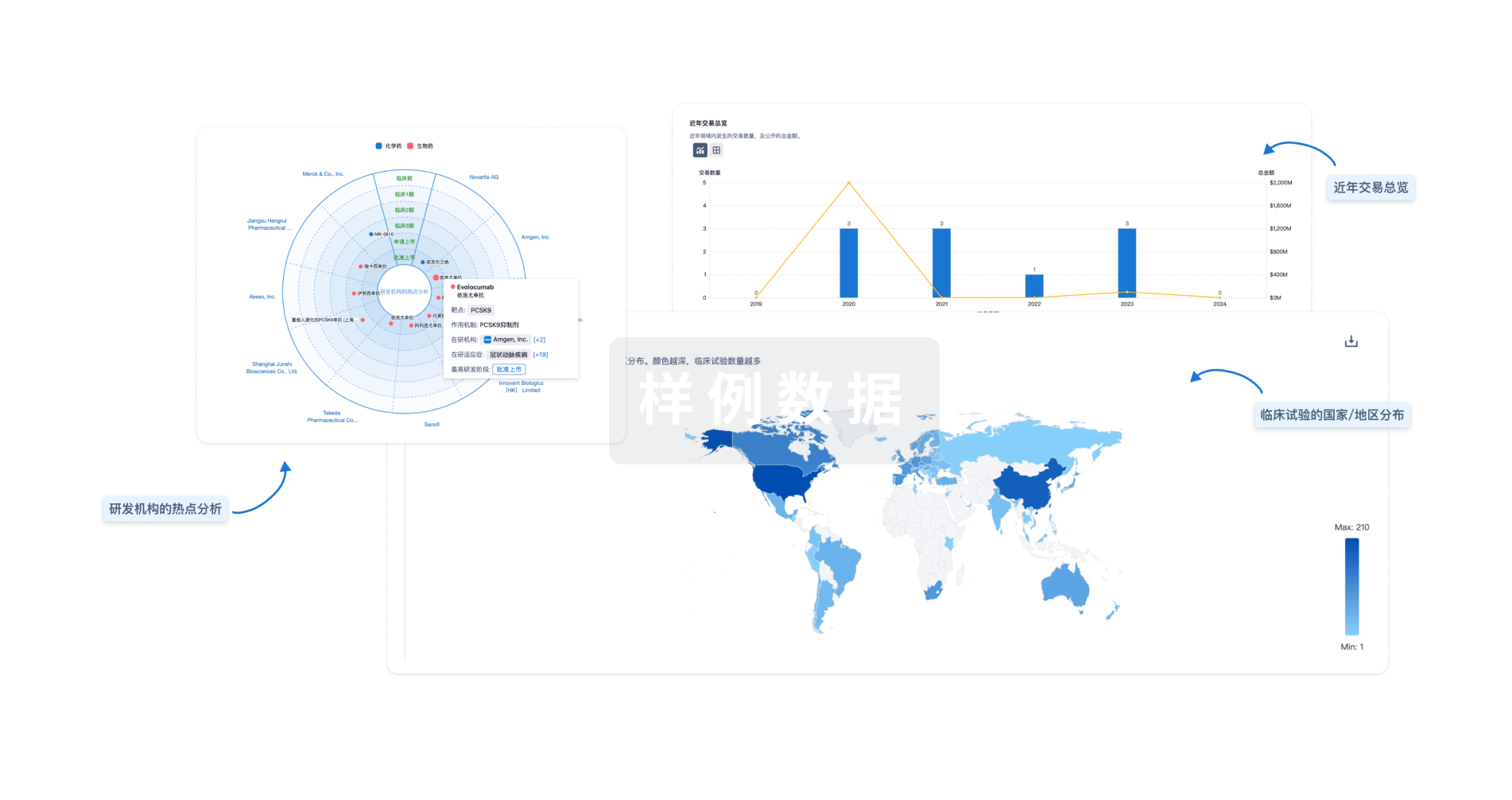预约演示
更新于:2025-05-07
IL-4Rα x TSLP
更新于:2025-05-07
关联
3
项与 IL-4Rα x TSLP 相关的药物作用机制 IL-4Rα调节剂 [+1] |
在研机构 |
原研机构 |
非在研适应症- |
最高研发阶段临床1期 |
首次获批国家/地区- |
首次获批日期1800-01-20 |
作用机制 IL-4Rα抑制剂 [+2] |
原研机构 |
在研适应症 |
非在研适应症- |
最高研发阶段临床申请批准 |
首次获批国家/地区- |
首次获批日期1800-01-20 |
作用机制 IL-4Rα抑制剂 [+1] |
非在研适应症- |
最高研发阶段临床前 |
首次获批国家/地区- |
首次获批日期1800-01-20 |
3
项与 IL-4Rα x TSLP 相关的临床试验CTR20251384
评估IBI3002在健康受试者和哮喘患者中多次给药的安全性、耐受性及药代动力学研究 —— 一项随机、双盲、安慰剂对照、剂量递增研究
评估健康受试者和哮喘受试者接受IBI3002多次剂量递增给药的安全性和耐受性,药代动力学和免疫原性特征。
开始日期- |
申办/合作机构 |
NCT06947408
A Study to Evaluate the Safety, Tolerability, and Pharmacokinetics of IBI3002 Multiple Dosing in Healthy Participants and Patients With Asthma - A Randomized, Double-Blind, Placebo-Controlled, Dose-Ascending Study
This study is a randomized, double-blind, placebo-controlled multiple dose ascending study in healthy participants and patients with asthma. Healthy participants will be enrolled in Part A and patients with asthma in Part B:
1. Part A: 40 healthy participants will be enrolled across 5 cohorts, including dose levels of 150mg, 300mg, 600mg, 900mg SC, and 600mg IV. In each cohort, there will be 8 participants randomized at a ratio of 6:2 to receive IBI3002 or matched placebo. The study consists of a screening period, a double-blind treatment period and a safety follow-up period. The study has a total duration of approximately 12 to 14 weeks.
2. Part B: 20 patients with asthma will be enrolled across 2 cohorts, including dose levels of 300mg and 900mg SC. In each cohort, there will be 10 participants randomized at a ratio of 8:2 to receive IBI3002 or matched placebo. The study consists of a screening period, a double-blind treatment period and a safety follow-up period. The study has a total duration of approximately 16 weeks.
1. Part A: 40 healthy participants will be enrolled across 5 cohorts, including dose levels of 150mg, 300mg, 600mg, 900mg SC, and 600mg IV. In each cohort, there will be 8 participants randomized at a ratio of 6:2 to receive IBI3002 or matched placebo. The study consists of a screening period, a double-blind treatment period and a safety follow-up period. The study has a total duration of approximately 12 to 14 weeks.
2. Part B: 20 patients with asthma will be enrolled across 2 cohorts, including dose levels of 300mg and 900mg SC. In each cohort, there will be 10 participants randomized at a ratio of 8:2 to receive IBI3002 or matched placebo. The study consists of a screening period, a double-blind treatment period and a safety follow-up period. The study has a total duration of approximately 16 weeks.
开始日期2025-04-30 |
申办/合作机构 |
NCT06213844
A Randomized, Double-Blind, Placebo-Controlled Single Ascending Dose Study to Evaluate the Safety, Tolerability, Pharmacokinetics and Pharmacodynamics of IBI3002 in Healthy Participants and Participants With Mild to Moderate Asthma
This is a single-center, randomized, double-blind, placebo-controlled, phase 1, single-ascending-dose study to evaluate the safety, tolerability, pharmacokinetics (PK) and pharmacodynamics (PD) of IBI3002 in healthy participants and mild to moderate asthmatics. Subjects will be randomly assigned to different dosages of IBI3002 and matched placebo groups. The entire trial cycle includes a 4-week screening period, 1-day treatment period and 5-week follow-up period.
开始日期2024-02-26 |
申办/合作机构 |
100 项与 IL-4Rα x TSLP 相关的临床结果
登录后查看更多信息
100 项与 IL-4Rα x TSLP 相关的转化医学
登录后查看更多信息
0 项与 IL-4Rα x TSLP 相关的专利(医药)
登录后查看更多信息
51
项与 IL-4Rα x TSLP 相关的文献(医药)2025-04-01·Journal of Allergy and Clinical Immunology
Targeting alarmins in asthma: From bench to clinic
Review
作者: Boyce, Joshua A ; Akenroye, Ayobami ; Kita, Hirohito
2025-01-01·The Journal of Allergy and Clinical Immunology: In Practice
Mucus Plug Score Predicts Clinical and Pulmonary Function Response to Biologic Therapy in Patients With Severe Asthma
Article
作者: Dinkel, Julien ; Mertsch, Pontus ; Gerckens, Michael ; Lenoir, Alexandra ; Mümmler, Carlo ; Kneidinger, Nikolaus ; Behr, Jürgen ; Götschke, Jeremias ; Götschke, Melanie ; Walter, Julia ; Milger, Katrin ; Spiro, Judith Eva ; Leuschner, Gabriele ; Barnikel, Michaela
2025-01-01·European Respiratory Review
Biologics in severe asthma: a state-of-the-art review
Review
作者: Gyawali, Bishal ; Khurana, Sandhya ; Georas, Steve N
210
项与 IL-4Rα x TSLP 相关的新闻(医药)2025-04-30
关注并星标CPHI制药在线过去25年,自身免疫性疾病治疗领域经历了从广谱抗炎到靶向精准调控的深刻变革(图1)。以肿瘤坏死因子(TNF)抑制剂(如英夫利昔单抗和阿达木单抗)为代表的细胞因子信号调节药物,奠定了免疫治疗创新的基石,并成为多适应症的标准疗法。近年来,随着白细胞介素(IL)家族抑制剂、JAK/TYK2激酶抑制剂及新兴靶点的崛起,行业正加速向精准化与多样化迈进。全球自身免疫药物市场已稳居第二大治疗领域,2024年TOP100畅销药中自免药物占比15款,总销售额达829.5亿美元。本文将深入分析当前靶点格局、跨疾病影响及未来创新方向。 图1.自身免疫性疾病机制的模式图[2]治疗靶点前景:从传统核心到新兴路径的扩展自 2020 年以来,已推出 4 种针对自身免疫性疾病的 first-in-class 药物,其中 3 种针对皮肤病适应症中的上皮屏障功能障碍和炎症(IL-13、IL-31 和 IL-36 抑制剂)。第四种也在皮肤病学中,是一种酪氨酸激酶 2 (TYK2) 抑制剂,可调节 IL-12 和 IL-23 等细胞因子下游的信号传导。在分析的 92 个治疗靶点中,正在研究的自免药物数量从 2020 年的 131 种增加到 2024 年的 193 种(+47%)(图2)。TNF超家族与IL家族的持续主导尽管TNFα抑制剂仍是基石,但靶向TNF超家族其他成员(如OX40、TL1A、BLyS/BAFF)的疗法正快速推进。2020年仅CD40/CD40L轴处于III期,而2024年TL1A、RANK等靶点药物已进入关键试验阶段,其中TL1A抑制剂在克罗恩病和溃疡性结肠炎中展现出潜力。IL家族则通过选择性增强(如IL-17A/F双靶点抑制剂)、长效化(如GSK的IL-5抑制剂depemokimab)及口服小分子(如礼来的IL-17口服药)实现迭代创新。IL-4、IL-33、IL-18等靶点的首 创新药(first-in-class)成为新焦点,而IRAK4因可同时抑制IL-1家族和Toll样受体信号,被视为多疾病干预的关键靶点(图2)。 图2.自免在研管线及产品[1]下游激酶与联合疗法的突破JAK抑制剂虽在风湿病等领域广泛应用(图2),但其对造血系统的副作用促使行业转向更具选择性的TYK2抑制剂。例如,百时美施贵宝的TYK2抑制剂Sotyktu通过调节IL-12/23通路,在银屑病中展现出优于传统JAK抑制剂的耐受性。联合策略(如IL-17+TNF双靶向、JAK/TYK2双激酶抑制剂)进一步拓宽治疗窗口,尤其在银屑病和克罗恩病中取得进展。2型炎症性疾病的关键靶点竞争针对特应性皮炎、哮喘等2型炎症疾病,IL-4/IL-13抑制剂(如度普利尤单抗)通过阻断IL-4Rα亚基,成为多适应症的重磅药物(图2)。TSLP抑制剂(如tezepelumab)则通过靶向上游警报素,在严重哮喘和COPD中取得突破。此外,IL-31(瘙痒通路)和IL-36(脓疱型银屑病)等新靶点的崛起,标志着皮肤病治疗的进一步细分。 跨疾病影响:从局部到系统的治疗革新皮肤病学的领先突破自2020年以来,皮肤病领域(图3)迎来多款创新药物:IL-13抑制剂:Tralokinumab和Lebrikizumab用于中重度特应性皮炎,显著改善表皮屏障功能。 IL-17A/F双靶点抑制剂:Bimekizumab在斑块状银屑病中实现更高缓解率(PASI90达80%以上),挑战TNF抑制剂地位。IL-36抑制剂:Spesolimab成为泛发性脓疱型银屑病的首个特异性疗法。JAK/TEC抑制剂:辉瑞的Litfulo作为首个获批的脱发治疗药物,凸显激酶抑制剂的多适应症潜力。 图3.一些典型自身免疫性疾病的模式图[2]风湿病与胃肠道疾病的扩展JAK抑制剂在类风湿性关节炎和强直性脊柱炎中持续扩展,选择性JAK1抑制剂(如乌帕替尼)因更低副作用备受青睐。胃肠道领域,IL-23抑制剂(如古塞奇尤单抗)在克罗恩病中对比传统疗法显示优效性,III期试验中内镜缓解率提升76%。嗜酸性食管炎则通过IL-4/13靶向药物(如度普利尤单抗)实现症状显著改善。呼吸系统与系统性疾病的新机遇首个TSLP抑制剂tezepelumab在严重哮喘中降低急性发作率,而IL-33靶向药物(如itepekimab)为COPD提供新治疗类别。系统性红斑狼疮(SLE)和干燥综合征(图3)则通过CD40/CD40L轴(如dazodalibep)和BAFF抑制剂探索突破。 未来展望:精准医疗与多维创新新兴靶点与首创新药的竞争TL1A与OX40/OX40L轴:默克的tulisokibart和罗氏的RVT-3101以及赛诺菲/Teva 的 duvakitug等TL1A抑制剂在炎症性肠病中进入III期,有望为克罗恩病和溃疡性结肠炎患者带来新的治疗方案;安进的 rocatinlimab 和赛诺菲的 amlitelimab 是靶向 OX40/OX40L T 细胞活化轴的新型药物,有望解决 IL-4 和 IL-13 产生的关键上游调节因子。IL-33:阿斯利康的tozorakimab(IL-33/ST2双靶点)和赛诺菲的itepekimab是两种针对 IL-33 的竞争性候选药物,预示COPD等呼吸疾病治疗的进一步分化。此外,CD40/CD40L轴可能引入全身性疾病的治疗替代方案,包括治疗干燥综合征的达唑达利贝 (Amgen) 和治疗系统性红斑狼疮的达匹利珠单抗 (Biogen/UCB)(图2)。 图2.按治疗领域划分的选定自身免疫性疾病的管道靶点前景(II 期和 III 期)的演变[1]从剂型优化到生物标志物中国自免市场快速增长,2030年预计达231亿美元,但生物药占比仍低于全球(2021年32.9% vs. 全球69.8%)。医保覆盖与仿制药冲击(如芦可替尼首仿上市)将加速市场洗牌,而国产IL-17抑制剂(恒瑞、智翔金泰)有望打破外资垄断。口服小分子(如礼来的IL-17口服药)与长效注射制剂(如每月一次的IL-5抑制剂)提升患者依从性。生物标志物驱动的分层治疗(如IL-23抑制剂的黏膜愈合指标)正成为临床研究核心,助力精准患者筛选。联合疗法与多适应症拓展IL-17+TNF双靶向策略在银屑病关节炎中探索协同效应,而JAK/TYK2双激酶抑制剂可能平衡疗效与安全性。多适应症布局(如度普利尤单抗覆盖皮炎、哮喘、嗜酸性食管炎)成为药企提升产品生命周期的重要策略。结语自身免疫治疗正迈向以机制驱动、患者为中心的新时代。未来十年,随着疾病特异性靶点的解析,以及基因编辑、多组学技术的应用,个体化治疗方案将逐步实现。中国凭借庞大的患者基数与创新药企崛起,或重塑全球市场格局。参考资料: [1]Fauconnier, Alexandre et al. “Trends in the drug target landscape for autoimmune diseases.”Nature reviews. Drug discovery, 10.1038/d41573-025-00061-7. 3 Apr. 2025,[2] Song, Yi et al. “Evolving understanding of autoimmune mechanisms and new therapeutic strategies of autoimmune disorders.”Signal transduction and targeted therapy vol. 9,1 263. 4 Oct. 2024, [3] Fugger, Lars et al. “Challenges, Progress, and Prospects of Developing Therapies to Treat Autoimmune Diseases.”Cell vol. 181,1 (2020): 63-80.END领取CPHI & PMEC China 2025展会门票来源:CPHI制药在线声明:本文仅代表作者观点,并不代表制药在线立场。本网站内容仅出于传递更多信息之目的。如需转载,请务必注明文章来源和作者。投稿邮箱:Kelly.Xiao@imsinoexpo.com▼更多制药资讯,请关注CPHI制药在线▼点击阅读原文,进入智药研习社~
免疫疗法临床3期临床结果临床2期
2025-04-27
中国南京和美国纽瓦克2025年4月27日 — 博奥信生物技术(南京)有限公司(简称:“博奥信”),一家处于临床阶段的全球化创新生物技术公司,宣布其合作伙伴Aclaris Therapeutics(NASDAQ: ACRS)在美国进行开发的新型双特异性抗TSLP/IL-4R抗体药物分子ATI-052(博奥信项目代号:BSI-502)获得FDA授予研究性新药(IND)许可,批准开展临床1a/1b期试验。“我们很高兴合作伙伴Aclaris Therapeutics在美国获得ATI-052的临床试验批准。”博奥信首席开发官兼美国分公司总裁林克丹博士表示。“临床前研究数据显示,ATI-052在免疫炎症疾病方面具有强大的治疗潜力。这进一步验证了博奥信Flexibody®双特异性抗体平台在发现和开发新型双特异性抗体疗法方面的独特优势。我们期待该药物在未来能为全球患者带来新的治疗方案。”“我们致力于开发创新疗法,而双特异性抗体作为免疫疗法的突破方向,必将推动多种疾病治疗方案的革新。”Aclaris Therapeutics总裁兼首席运营官Hugh Davis博士表示。“作为博奥信授权合作的关键资产,ATI-052资产具有同类最佳潜力的TSLP/IL-4R双特异性候选抗体,可通过高亲和力结合并同时阻断TSLP配体与IL-4受体,从而抑制关键的促炎通路中枢。开发免疫炎症疾病领域的双特异性抗体是Aclaris的重点布局方向,此次获得FDA的IND许可,标志着我们在ATI-052开发进程上取得重要里程碑。"这项随机、双盲、安慰剂对照的1a/1b期临床试验将评估ATI-052的单次和多次递增剂量给药方案,随后在未公开的适应症中进行概念验证研究。Aclaris计划于2025年第二季度启动该项试验。双特异性抗体经过改造具有两个不同的结合域,可同时与两个靶点结合。这种双重结合和通路抑制的机制相比于传统单克隆抗体可能具有更强的疗效,在多种免疫调节疾病的潜在治疗中具有广泛应用前景。关于ATI-052(BSI-502)ATI-052(博奥信项目代号:BSI-502)是一种潜在的同类最佳抗TSLP/IL-4R双特异性抗体,正在开发用于特定免疫炎症疾病的新疗法。该药物可同时靶向胸腺基质淋巴细胞生成素(TSLP)和白细胞介素-4受体(IL-4R),通过阻断上游TSLP受体信号转导和下游IL-4R激活,抑制IL-4与IL-13信号通路,从而阻断这一核心促炎通路。其双通路抑制机制可能带来更强的疗效优势。ATI-052采用了与Aclaris在研抗TSLP单抗Bosakitug(ATI-045/BSI-045B)相同的TSLP抗原结合片段(Fab)区域,但经过工程化改造增强了与新生儿Fc受体(FcRn)的结合能力,有望延长药物半衰期。该候选抗体具备治疗多种特应性、免疫性及呼吸道疾病的潜力。2024年11月,博奥信将ATI-052(BSI-502)在大中华区以外的产品开发和商业化权益授权给Aclaris,博奥信保留大中华区的产品开发和商业化权益。关于Aclaris TherapeuticsAclaris Therapeutics是一家临床阶段生物制药企业,致力于开发创新候选药物管线,以满足免疫炎症疾病患者未被充分满足的临床需求。公司通过强大的研发引擎构建了覆盖多阶段的候选产品组合。欲了解更多信息,请访问官网http://www.aclaristx.com。关于博奥信博奥信是一家全球临床阶段的生物技术公司,致力于开发创新的抗体疗法,以改善免疫和肿瘤疾病患者的治疗效果。公司依托自主研发的核心技术平台,包括H³抗体发现平台、SynTracer® HT内吞平台以及Flexibody®双特异性抗体平台,开发出高度差异化的创新药物,解决全球范围内尚未满足的医疗需求。通过“发现-开发-合作”的灵活模式,博奥信已建立了10项全球合作项目,其中8个项目已经进入临床阶段,包括单克隆抗体、双特异性抗体和抗体药物偶联物(ADC)。博奥信在美国、中国和澳大利亚设有运营机构。更多信息,请访问www.Biosion.com。
临床申请免疫疗法临床2期
2025-04-22
·医药速览
2025年4月10日,CDE相关平台公示了一项来自信达生物的双抗药物IBI3002的临床实验登记信息,用以评估其在健康受试者和哮喘患者中多次给药的安全性和PK,PD,免疫原性的I期研究(CTR20251384)。IBI3002的临床信息而在4月17日,信达生物也公开了IBI3002药物的相关专利。IBI3002专利技术解读首先,为了验证同时阻断IL-4Rα和TSLP是否会对 II 型免疫带来更强的阻断和抑制作用,信达采用了两种不同的功能实验来进行概念证明:1. 利用人外周血单个核细胞(PBMC)来确定由IL-4/IL-13通过IL-4Rα诱导并由TSLP通过TSLPR诱导的CCL-17的释放活性,以及三者之间的协同效应。由上图看出:当三种细胞因子混合用于细胞处理时,它们在较低浓度(0.1-0.3 nM)下对CCL-17 的释放的增加显示出了显著的协同作用。2. 为了更好地模拟CCL-17在生理疾病条件下的释放,信达又使用了不同的抗体组合来检测来进行验证。由上图看出:抗TSLP抗体和抗IL-4Rα抗体的组合在实验条件下表现出良好的抑制作用,CCL-17释放功能完全阻断在较低浓度(0.06 nM),优于单一治疗组。接下来,通过检测Th2细胞因子的释放来确定TSLP的分化功能。由上图看出:用TSLP和T细胞刺激的DC,可显著增强Th2细胞因子的释放(例如,IL-5/IL-13)。相反,仅用TSLP或CD4+ T细胞刺激的DC仅部分释放或不释放IL-5或IL-13。由上图看出:对于IL-5的释放,每个测试组的抑制水平相当,抗TSLP抗体(tezepelumab)的抑制水平较低,表明单独抑制TSLP无法完全抑制由T细胞介导的DC的分化和成熟功能;而对于IL-13的释放,单独施用抗IL-4Rα抗体(dupilumab)或抗TSLP抗体几乎不能抑制其释放,而抗IL-4Rα抗体和抗TSLP抗体的组合施用可以以剂量依赖性方式显著抑制其释放。以上数据证明,同时阻断TSLP和IL-4Rα可以显著抑制单核细胞,特别是抗原呈递细胞如树突细胞对Th2细胞的相关细胞因子和趋化因子的活性,募集和释放的影响。此外,预期抗IL-4Rα/TSLP双特异性抗体可在Th2介导的炎性疾病中发挥更强的功效。基于以上结果,信达设计了三种双抗的结构:并对以上三种双抗进行了活性的验证(抗体阻断实验以及功能性验证):结果显示,抗IL-4Rα抗体的二价形式比一价形式具有明显更好的阻断活性,而单价抗TSLP分子可实现完全与二价形式相当的阻断活性;而F-1 是TSLPR,其具有阻断TSLP功能,但其活性不优于抗TSLP抗体 tezepelumab。 基于上述数据, 2 + 2 格式(IgG-scfv)被选择为最终分子形式。然而,考虑到一些抗体在转化为scfv形式时可能经历活性的降低,TSLP抗体筛选以scfv的形式进行,从而获得具有高阻断活性的克隆。随后,信达进行了抗IL-4Rα抗体的杂交瘤的制备和嵌合体的构建。经过系统的筛选后,得到了与对照抗体dupilumab的阻断活性相当的嵌合抗体Ch10H4.6。接着,对该嵌合体进行了人源化改造。并通过BLI实验检测该人源化抗体的解离常数,结果如下:接下来,对该人源化抗体进行了亲和力成熟改造,通过对IL-4Rα的亲和力测试筛选出如下抗体:以上候选分子对IL-4Rα的亲和力与 dupilumab 相当。接下来,信达进行了体外功能测试,来检测 抗IL-4Rα候选抗体对IL-4/13 诱导的 TF-1 细胞增殖的抑制作用,结果如下:结果表明,所有候选分子和 dupilumab 能有效抑制IL-4 和IL-13 诱导的TF-1 细胞增殖,具有相当的活性。接下来, 同样的流程筛选到了抗TSLP的嵌合体,亲和力检测结果如下:体外功能分析的结果如下:报告基因检测结果表明,11h7E11嵌合抗体比 tezepelumab 具有更好的阻断活性。体外诱导实验表明,11h7E11嵌合抗体和scfv抗体比tezepelumab具有更强的阻断活性。接下来进行人源化,信达以IgG1 lala亚型作为IgG恒定区骨架,将得到的抗体通过BLI实验来检测亲和力,结果如下:上图数据显示,人源化抗体Hz11H7 保持与嵌合抗体相当的亲和力。随后,信达开始进行双抗的构建,分子结构示意图如下:将得到的双特异性抗体进行与抗原结合的动力学实验(BLI):结果显示,抗TSLP端的双特异性抗体的抗体亲和力检测与单克隆抗体相似,所有四个候选分子对TSLP的解离常数(kd)值约为 2.50E-10 M,其与tezepelumab相当。下面,信达对双特异性抗体的连接子进行了优化。通过构建不同的连接子,对双抗进行了热稳定性的检测:信达将重链可变区通过连接子2(4 × G4S)连接到抗TSLP抗体的轻链可变区,通过连接子1(6 × G4S)连接到IL-4Rα单克隆抗体分子的Fc结构域的C端,从7A的峰图可以看出热稳定性并不理想。随后,通过用 GGGGG(G5), 3 ×(G5)和 4 ×(G5)代替 6 × G4S来优化接头长度,以分别产生H6-5G-hz11H7-2-scfv, H6-15G-hz11H7-2-scfv和H6-20G-hz11H7-2-scfv。结果表明,不同的接头长度对阻断功能没有影响(图 8A-8B)。然后,选择具有最短链接子的分子(H6-5G-hz11H7-2-scfv)进行热稳定性测试,结果显示该分子在聚集或碎裂产物(图 7B)中没有显示任何显著增加。在确定了连接子的长度和序列后,进行了双特异性抗体对hIL-4和hIL-13诱导的TF-1 细胞增殖的抑制实验。结果表明:所有双特异性抗体和Dupilumab都能有效抑制IL-4和IL-13诱导的TF-1细胞增殖。接下来,信达进行了双特异性抗体结合TSLP的CTLL2报告基因细胞活性实验。结果表明,所有测试的双特异性抗体和tezepelumab都有效地抑制了TSLP与TSLPR/IL7R在CTLL2报告基因单元表面的结合。与对照抗体tezepelumab相比,测试的双特异性抗体通过结合TSLP表现出优异的对CTLL2报告基因细胞活性的抑制。随后,信达检测了双特异性抗体对由hIL-4,hIL-13和TSLP诱导的PBMC释放CCL-17的抑制效果。结果显示,双特异性抗体抑制了CCL-17从IL-4/IL-13诱导的PBMC中的释放(11A)。并且有效地抑制了CCL-17从TSLP诱导的PBMC中的释放,其抑制活性显著优于对照抗体tezepelumab,dupilumab和tezepelumab组合组(11B)。同样地,双特异性抗体有效抑制了CCL-17从IL-4,IL-13和TSLP共同诱导的PBMC中的释放,抑制活性显著优于对照抗体dupilumab,dupilumab和tezepelumab组合组。综合以上实验结果,表明了与现有的ani-IL-4Rα单克隆抗体和抗TSLP单克隆抗体相比,该双特异性抗体对当前批准的药物dupilumab和tezepelumab具有相当或优异的效果。接下来,信达开始转向体内实验,检测双特异性抗体对哮喘小鼠的治疗作用。在用OVA致敏和刺激之后,模型对照IgG组中的淋巴细胞数量高于空白对照组。CD45阳性细胞的数目,以及嗜酸性粒细胞,单核细胞和嗜中性粒细胞的数目在dupilumab和双特异性抗体组的小鼠的外周血中显著降低。小鼠双特异性抗体的药代动力学研究结果如下:随后,信达对上述四个双抗分子的Fc区三个位点(YTE)进行定点突变,进一步增强其对人FcRn的结合能力,从而延长其在体内的半衰期。用fortebio用来检测上述抗体和人FcRn之间的亲和性。如所预期的,在特定条件下,YTE突变将亲和力增加10倍以上。最后,确定了抗体血清药物浓度以及药代动力学参数,结果如下:(该专利中构建的其它三个YTE分子表现出与D5-11H7-YTE相当的药代动力学性质。)基于以上结果,信达的IBI3002目前的临床研究进展以及分子结构图公布于其官网:欢迎感兴趣的朋友欢迎进群讨论,群二维码如下:推文用于传递知识,如因版权等有疑问,请于本文刊发30日内联系医药速览。原创内容未经授权,禁止转载至其他平台。有问题可发邮件至yong_wang@pku.edu.cn获取更多信息。©2021 医药速览 保留所有权利往期链接“小小疫苗”养成记 | 医药公司管线盘点 人人学懂免疫学| 人人学懂免疫学(语音版)综述文章解读 | 文献略读 | 医学科普|医药前沿笔记PROTAC技术| 抗体药物| 抗体药物偶联-ADC核酸疫苗 | CAR技术| 化学生物学温馨提示医药速览公众号目前已经有近12个交流群(好学,有趣且奔波于医药圈人才聚集于此)。进群请扫描上方二维码,备注“姓名/昵称-企业/高校-具体研究领域/专业”,此群仅为科研交流群,非诚勿扰。简单操作即可星标⭐️医药速览,第一时间收到我们的推送①点击标题下方“医药速览” ②至右上角“...” ③点击“设为星标
临床1期
分析
对领域进行一次全面的分析。
登录
或

生物医药百科问答
全新生物医药AI Agent 覆盖科研全链路,让突破性发现快人一步
立即开始免费试用!
智慧芽新药情报库是智慧芽专为生命科学人士构建的基于AI的创新药情报平台,助您全方位提升您的研发与决策效率。
立即开始数据试用!
智慧芽新药库数据也通过智慧芽数据服务平台,以API或者数据包形式对外开放,助您更加充分利用智慧芽新药情报信息。
生物序列数据库
生物药研发创新
免费使用
化学结构数据库
小分子化药研发创新
免费使用



